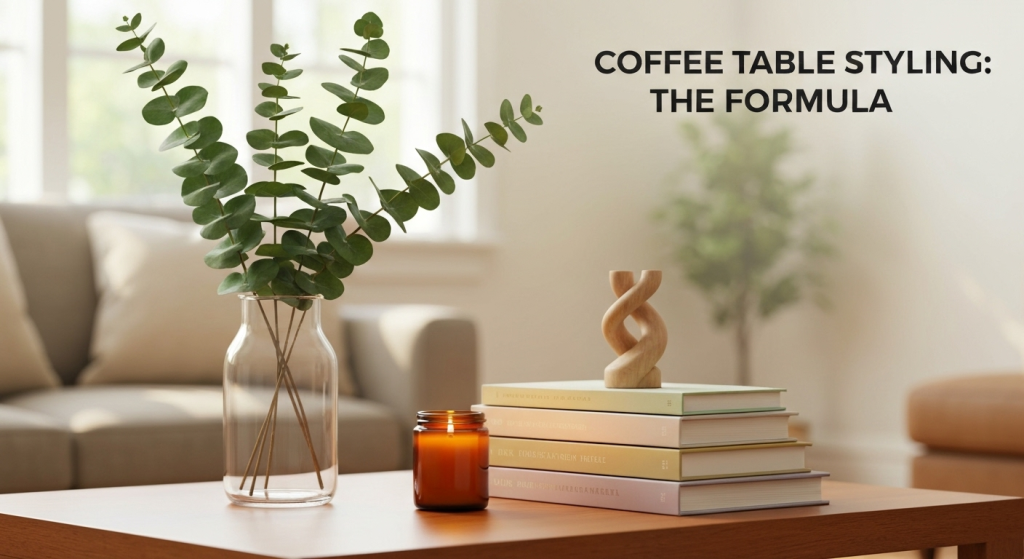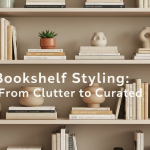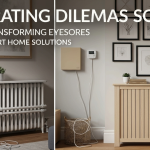A perfectly styled coffee table can be the centerpiece that pulls your entire living room together. But let’s be honest, getting it right can feel like a mystery. Your coffee table might be a barren wasteland, holding nothing but a remote control and a coaster. Or, it could be the opposite: a cluttered drop-zone for mail, keys, and yesterday’s coffee mug. If you’ve ever looked at a beautiful room in a magazine and wondered how they make it look so effortlessly chic, the secret often lies in a simple, repeatable formula.
Forget the guesswork and overwhelming choices. The key to a beautifully balanced coffee table isn’t about buying expensive decor; it’s about understanding composition. What this really means is learning how to arrange a few key items to create a look that is both stylish and personal. We are going to break down a simple, four-part formula that works for any style, any budget, and any coffee table. It’s a method that turns styling from a chore into a creative and enjoyable process.
My name is William Johnson, and for years, I’ve been fascinated by the stories our homes tell. My passion isn’t just about what’s trendy, but about how arranging objects in a thoughtful way can make a space feel more personal and inviting. I’ve spent a good part of the last five years working with different spaces, observing how small changes can make a huge impact. I don’t see home decor as a rigid set of rules, but as a language. Through my writing, I aim to translate that language, sharing what I’ve learned through hands-on experience so you can feel more confident in creating a home you truly love.
The Core Four: Your Coffee Table Styling Formula
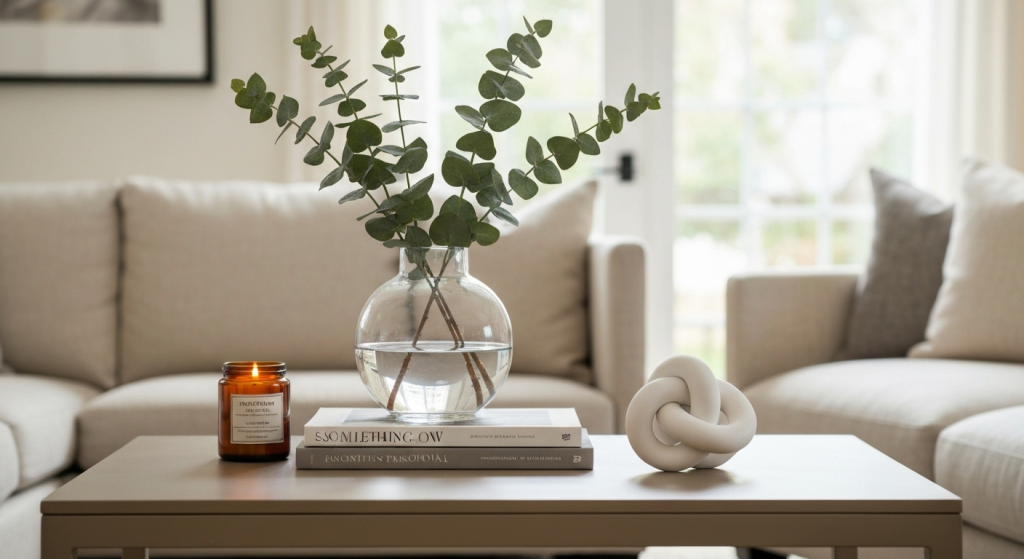
The foundation of a well-styled coffee table rests on four essential elements. Think of these as the key ingredients in a recipe. Each one plays a specific role in creating visual interest, balance, and personality. When brought together, they create a harmonious arrangement, or what designers call a “vignette.”
Let’s break down each component of the formula:
- Something Tall: To add height and drama.
- Something Low: To ground the arrangement.
- Something Sculptural: To add an interesting shape.
- Something Personal: To make it feel like your home.
This formula works because it creates variation in height, shape, and texture, which is what makes any design visually appealing.
Element 1: Something Tall – The Anchor
Your first item needs to create some verticality. A flat landscape of objects can look boring and stagnant. A tall element immediately draws the eye upward, breaking up the horizontal plane of the coffee table and adding a sense of life and dimension to the arrangement. It acts as the visual anchor.
What to Use:
- A Vase with Flowers or Stems: This is a classic for a reason. Fresh flowers add color and a natural element. For a lower-maintenance option, consider dried branches, eucalyptus stems, or even high-quality faux greenery. The key is finding a vase with a shape you love.
- Tall Candlesticks: A pair of elegant, slender candlesticks (or a single, substantial one) can add a touch of sophistication and height.
- A Slender Sculpture or Statue: A piece of art can serve as your tall element, doubling as a conversation starter.
My Experience: I’ve found that a clear glass vase is incredibly versatile. It doesn’t add much visual weight, so the focus remains on the flowers or stems inside. It keeps the arrangement feeling light and airy, which is perfect for smaller living rooms. If you want to make a bigger statement, an opaque ceramic or stone vase can add texture and color.
| Tall Item Type | Pros | Cons | Best For… |
| Vase with Fresh Flowers | Adds life, color, and natural scent. | Requires regular replacement and water changes. | Bright, traditional, or bohemian spaces. |
| Vase with Dried Stems | Low maintenance, long-lasting, adds texture. | Can be delicate and gather dust. | Minimalist, rustic, or modern farmhouse styles. |
| Tall Candle Holders | Adds elegance and potential for ambient light. | Can be a fire hazard if using real candles. | Formal, classic, or romantic decor schemes. |
| Slender Sculpture | Unique, artistic, and a strong focal point. | Can be more expensive; needs to fit your style. | Modern, eclectic, or contemporary homes. |
Pro Tip: Make sure your tall item isn’t so tall that it blocks the view of the TV or obstructs conversation with someone sitting across from you. A good rule of thumb is to keep it under 15 inches.
Element 2: Something Low – The Foundation
Next, you need to ground your tall anchor with something low and horizontal. This element often provides a base for other items and adds intellectual or organizational weight to your display. It’s the foundation upon which the rest of your vignette is built.
What to Use:
- A Stack of Books: Coffee table books are the quintessential choice. They add color, personality, and a place to rest other objects. Choose books with interesting spines and covers that relate to your hobbies, interests, or color scheme.
- A Decorative Tray: A tray is a stylist’s best friend. It corrals smaller items (like remotes or coasters), preventing the table from looking cluttered. It defines a space and makes the whole arrangement feel intentional. Trays come in countless materials—wood, metal, marble, rattan—so you can easily find one that matches your decor.
- A Large, Flat Bowl: A wide, shallow bowl made of wood, ceramic, or metal can serve as a beautiful foundational piece. You can leave it empty or use it to hold decorative orbs or other small items.
My Experience: I almost always start with either a tray or a stack of books. Three books is often the magic number for a stack—it provides enough height without looking like a library tower. When choosing books, don’t be afraid to take the paper jackets off. Often, the hardcover underneath is a beautiful, simple color that works better with your decor.
Element 3: Something Sculptural – The Conversation Starter
This is where you can inject some real personality and artistic flair. The sculptural element is an object with an interesting or irregular shape. It breaks up the straight lines of books and the verticality of a vase, adding a layer of intrigue and sophistication. It’s the piece that makes people look twice.
What to Use:
- A Natural Object: Think of a piece of coral, a large crystal, a beautiful rock, or a piece of driftwood. These items bring organic texture and form into your living room.
- A Man-Made Object: This could be a small ceramic sculpture, a wooden chain link object, a glass knot, or a brass geometric shape. It’s an opportunity to showcase your unique style.
- A Small Potted Plant: A succulent or a small plant in a unique pot is a perfect choice. It combines a natural element with a sculptural shape.
Pro Tip: Place your sculptural object on top of your stack of books. This gives it a little extra height and prominence, making it feel more special and intentional. This simple layering trick instantly makes the arrangement look more professional.
Element 4: Something Personal – The Heart of Your Home
The final piece of the formula is what truly makes the coffee table yours. It should be an item that tells a story, evokes a memory, or simply brings you joy. Without this element, your coffee table might look like a page from a catalog—beautiful, but sterile. The personal touch is what breathes life into the arrangement.
What to Use:
- A Scented Candle: A candle in a beautiful jar adds a sensory element to the display. The scent can make your living room feel cozier, and the soft glow of a lit candle is always inviting.
- A Small Dish or Box: A little ceramic dish is perfect for holding small items, or it can simply be a decorative piece. A small, ornate box can hide away less attractive necessities like matches or a remote.
- A Framed Photo: A small, simple frame with a picture of loved ones or a favorite travel memory is a wonderful personal touch.
- A Memento: This could be a beautiful stone you picked up on a beach, a small souvenir from a trip, or a piece inherited from a family member.
This element doesn’t need to be grand. In fact, its power lies in its subtlety. It’s a small wink to your own life and story.
Assembling Your Perfect Vignette: A Step-by-Step Guide
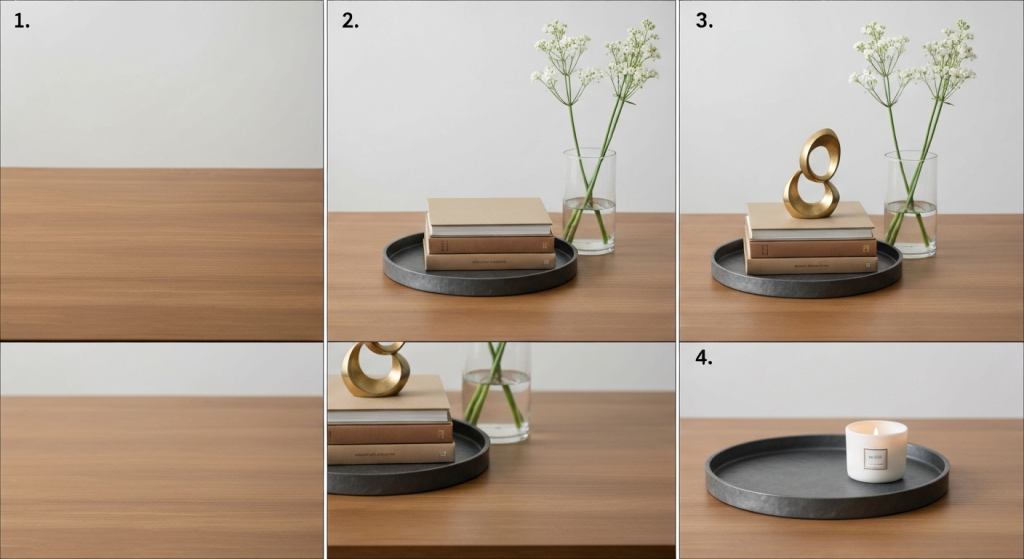
Now that you have your four core elements, how do you put them all together? The key is to think about balance and flow. You want to create a “visual triangle,” where your objects are arranged at different heights to guide the eye around the display.
Here’s a simple process to follow:
- Start with a Clean Slate: Completely clear off your coffee table. This gives you a fresh perspective and allows you to build the arrangement from scratch.
- Place Your Foundation: Begin with your “something low.” If you’re using a tray, place it first, slightly off-center. If you’re using a stack of books, place them where they feel most natural, often angled toward a corner or edge.
- Add Your Height: Next, place your “something tall” (the vase or candlestick). A great starting point is to place it next to or behind your stack of books. If using a tray, place it toward one side of the tray. This starts to build that visual triangle.
- Incorporate the Sculptural Piece: Now, add your “something sculptural.” A classic placement is right on top of your stack of books. This elevates the object and integrates it into the arrangement. If you’re using a tray, you can place it next to your tall item.
- Finish with a Personal Touch: Finally, place your “something personal.” A small candle or dish can be placed next to the books or in a corner of the tray. This small final item completes the vignette.
- Step Back and Adjust: Take a few steps back and look at the arrangement from different angles. Does it feel balanced? Is there enough space between items? Don’t be afraid to nudge things around until it feels just right. There should be some “breathing room” so the table doesn’t look crowded.
Beyond the Basics: Adapting the Formula for Your Style & Table Shape
The beauty of this four-part formula is its flexibility. It’s a starting point, not a rigid rule. You can easily adapt it to fit the shape of your coffee table and your personal design aesthetic.
For Different Table Shapes
- Round or Square Coffee Tables: These shapes work well with a central cluster. Group your four items toward the middle of the table, creating a tight, cohesive vignette. You can also think of the table as a pie and arrange items in one of the “slices” to leave room for drinks.
- Rectangular or Oval Coffee Tables: These longer tables give you more room to play with. You can either create one main vignette off-center or break the table into two or three “zones.” For example, you could have a tray with three of your items on one side and leave the other side for your stack of books.
Matching Your Decor Style
This formula can be interpreted in countless ways to match your home’s style. The key is in the specific objects you choose.
| Decor Style | Something Tall | Something Low | Something Sculptural | Something Personal |
| Minimalist | A single dried branch in a simple ceramic vase. | A stack of two books with neutral spines. | A simple black metal knot or a smooth stone. | A sleek, unscented candle in a concrete vessel. |
| Bohemian | A textured terracotta vase with pampas grass. | A round rattan tray. | A small, leafy plant in a macrame hanger. | A hand-painted ceramic dish for incense. |
| Modern Farmhouse | A rustic white pitcher with faux lavender. | A stack of vintage-looking books tied with twine. | A carved wooden dough bowl or bead garland. | A scented candle in an amber glass jar. |
| Glam/Modern | A tall, metallic candle holder. | A mirrored tray or a book on fashion design. | A clear crystal geode or a gold geometric object. | A small, elegant box for storing coasters. |
Common Coffee Table Styling Mistakes (And How to Fix Them)
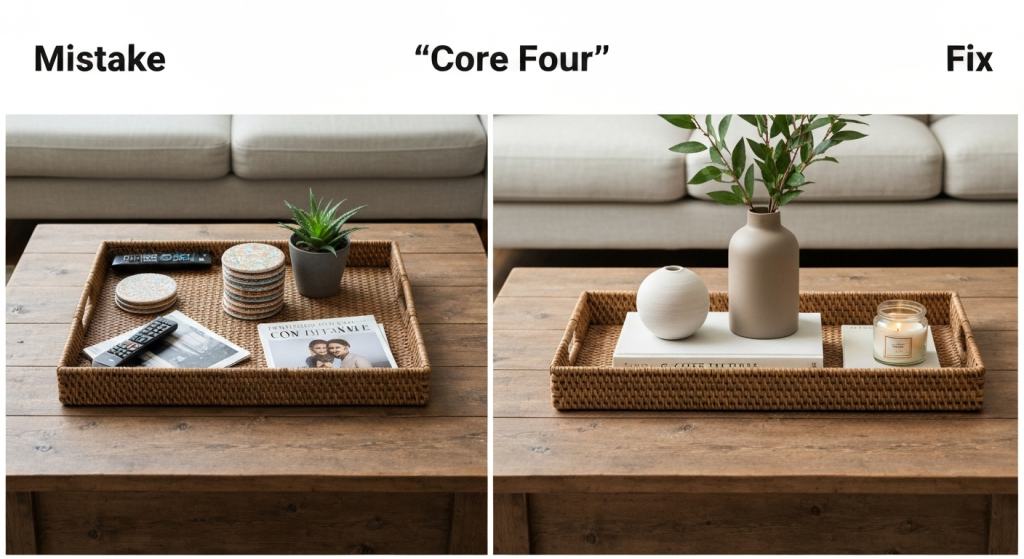
If your arrangement still doesn’t feel right, you might be making one of these common mistakes. The good news is that they are all easy to fix.
- The Mistake: It’s Too Flat. Everything is roughly the same height, creating a boring, one-dimensional look.
- The Fix: This is exactly what the “something tall” element is for! Swap one of your shorter items for a vase with branches or a pair of candlesticks to instantly introduce varying heights.
- The Mistake: It’s a Cluttered Mess. You have too many small, disconnected items scattered around.
- The Fix: Use a decorative tray. A tray acts like a frame, instantly grouping disparate items into a single, organized vignette. It tells your eye, “These things belong together.”
- The Mistake: It Looks Impersonal and Staged. Your table looks nice, but it feels like it belongs in a furniture showroom, not a home.
- The Fix: Revisit your “something personal” item. Is it truly something that reflects you? Swap a generic decor piece for a framed photo, a memento from a trip, or your favorite scented candle. This is the easiest way to inject warmth and personality.
- The Mistake: It’s Completely Impractical. The table is so full of decor that there’s no room to put down a drink, a book, or your feet.
- The Fix: Remember that a coffee table is functional furniture. Scale down your arrangement. Group your items tightly on a tray to one side, leaving at least half of the table surface free for everyday use. Style should enhance your life, not get in the way of it.
Frequently Asked Questions
How often should I change my coffee table decor?
There’s no set rule! Some people enjoy changing it with the seasons—adding fresh flowers in the spring, a bowl of pinecones in the fall, or a festive candle in the winter. Others prefer to find a look they love and stick with it. A good middle ground is to refresh one or two items, like the flowers or the candle, every few weeks to keep it feeling new.
What if I have kids or pets?
Safety and practicality come first. Opt for soft, unbreakable items. Instead of a glass vase, choose a sturdy wooden or ceramic one. Swap breakable sculptures for woven objects or wooden beads. Instead of real candles, use high-quality flameless LED candles. A tray is also very helpful for quickly clearing the table when it’s time for board games or crafts.
Can I use more than four items?
Absolutely. The “Core Four” is a starting point to teach you the principles of balance. The “Rule of Threes” (or any odd number) is a popular design principle. You could have a group of three candlesticks as your “tall” element or a stack of three books as your “low” element. As long as you maintain a mix of heights, shapes, and textures, you can expand on the formula.
Where can I find unique sculptural objects?
You don’t need to spend a lot of money. Home goods stores are a great start, but also think outside the box. Flea markets, thrift stores, and even nature walks can yield interesting finds. A unique rock, a piece of driftwood, or a vintage brass object can add far more character than a mass-produced item.
Conclusion: Your Table, Your Story
Styling your coffee table shouldn’t be intimidating. By breaking it down into a simple, four-part formula—something tall, something low, something sculptural, and something personal—you have a reliable roadmap to create a beautiful and balanced arrangement every single time. This method is not about perfection; it’s about expression.
Think of your coffee table as a small canvas in the center of your living room. It’s an opportunity to tell a little story about who you are, what you love, and the life you live. So gather a few of your favorite things, play around with the arrangement, and have fun with it. You now have the formula to turn that empty or cluttered surface into a stylish focal point that truly feels like home.
